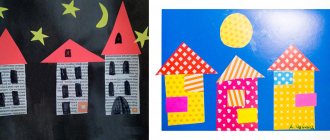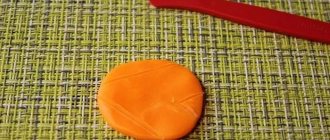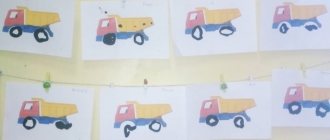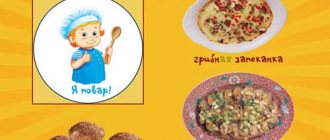Composition options based on theme
In the visual arts program for the middle group, mushroom sculpting is offered to children in October (after all, these are the same gifts of autumn as vegetables and fruits). The topic can be defined more specifically, for example, “Handsome Fly Agaric” or “Boletus”, focusing on the characteristics of a particular mushroom.
You can suggest a topic such as “Mushrooms for a hedgehog” (squirrels, forest animals). The teacher plays out a specific image of an animal in the motivational part of the lesson.
In addition, the children can sculpt mushrooms in the clearing. This can be individual (3-4 mushrooms on the grass) or a collective composition. In the second case, the teacher prepares a large base: it can be a sheet of A3 cardboard, painted green, artificial grass, moss, etc.
The clearing (the basis for collective modeling) is prepared by the teacher using cardboard, paper, artificial grass and other materials
Another version of the theme is “Basket with mushrooms.” Again, it can be played out as individual and collective work. The children can make small baskets where they will place their mushrooms (several pieces), or the teacher prepares a basket in advance (for example, from cardboard strips), and the children put their mushrooms there.
Each child builds a basket in the most convenient way
During the lesson you can also sculpt mushrooms and berries (fruits of the forest) at the same time. For example, on the cap of a large mushroom or next to it there may be a raspberry or a sprig of currant made of plasticine.
Summary of joint activities in the middle group. Modeling "Mushrooms".
. Look, guys, where have we ended up? Children, who can you meet in the forest?Who else lives in the forest?
Let's stretch our boys and play a finger game. “I’ll pick mushrooms” Finger game “I’ll pick mushrooms I take a basket into the forest, they show surprise, they breed There I’ll pick mushrooms. hands to the sides My friend is surprised: “How many mushrooms are there around here! » Boletus, butterfly, alternately bend the fingers Boletus, honey fungus, fingers on both hands, starting Boletus, chanterelle, milk mushroom - from the little finger of the right hand. Let them not play hide and seek! Saffron milk caps, little waves I'll find them at the edge of the forest. I'm returning home, taking all the mushrooms with me. But I won’t carry the fly agaric. The thumb of the left hand has fallen behind - Let it remain in the forest! Well done! I liked the game ?
Now let's look at them. What does each mushroom have?
—What kind of legs do mushrooms have?
- What kind of leg does a porcini mushroom have?
- Look at the hat, what is it like?
Look guys, what beautiful mushrooms we will sculpt today from plasticine
Before we start sculpting, let’s remember the rules for working with plasticine.
- In order for us to get a mushroom, we first need to mold the stem, and then the cap.
- How do we sculpt a leg? What movements?
Just make sure that the sausage is thick and short, and not thin and long. But our leg is thinner on one side, what needs to be done? On one side you need to take it with three fingers - thumb, index and middle and pull it back a little, squeezing your fingers a little. This technique is called pulling. See if our leg is thick on one side and thinner on the other.
-Now let's make a hat. What shape does the hat have? So, how are we going to roll the plasticine? We have a ball for a hat. Please note that in the middle the cap is convex, it has a recess for the stem, and closer to the edges it becomes thin. We flatten the ball a little, without pressing hard on our palms, and we will get a circle. Here we will also use the pulling technique. What sculpting technique will we use? What is it called? Now we place our thumb in the middle of the circle from below, and from above with two fingers, index and middle, we begin to slowly press and at the same time pull the plasticine down. Look, we have a round and convex hat.
-What now needs to be done to make a mushroom? (Connect the stem and the cap). Move the plate with plasticine towards you
- start sculpting right away. First the leg, then the cap, . Whoever does it first can quietly take more plasticine and make another mushroom. There is no need to break or pinch off pieces from the piece. We work with the whole piece.
Children do their own work ,
under the supervision of a teacher
During the work, I remind you once again that you need to work with plasticine carefully; if a piece of plasticine falls on the floor, you need to pick it up.
Implementation of an individual approach when sculpting mushrooms
Since the image of a mushroom in modeling can be embodied with varying degrees of complexity, this topic is very suitable for implementing an individual approach in class. Thus, children who have well-developed fine motor skills can work on the craft in more detail, marking the “skirt” of the mushroom and drawing notches-plates in a stack.
The same applies to the number of elements of the composition. As part of the theme “Mushrooms in the Meadow,” some will make just two mushrooms, while others will make a whole large family.
When sculpting mushrooms, you can successfully use an individual approach
Artistic and aesthetic development - modeling. "Basket with mushrooms"
08/29/2017 Tuesday (7-13)
Lesson notes for senior and preparatory groups
on the topic:
“Basket with mushrooms” artistic and aesthetic development, Modeling .
T. S. Komarova page 15
Target:
exercise children in conveying the shape of different mushrooms using finger sculpting techniques; consolidate the ability to sculpt a basket; clarify knowledge of forms; cultivate the desire to achieve good results.
Tasks:
Educational:
identify skills in working with plasticine; encourage children to make a basket of mushrooms; consolidate the ability to classify mushrooms (edible - inedible).
Developmental:
develop the ability to convey some characteristic features of mushrooms (deepening, curved edges, thickening legs); develop the ability to use familiar sculpting techniques (sculpting an object from separate parts, rolling a ball, rolling out columns by moving your palms back and forth on a board, connecting parts into a single whole and smoothing the joints); development of visual-figurative thinking, voluntary attention, memory, creativity, fine motor skills.
Educational:
cultivate accuracy in working with plasticine; cultivate interest in fine arts; cultivate the ability to enjoy the crafts made.
Materials for the lesson:
modeling board; plasticine, stack.
Progress of the lesson:
Educator:
“Guys, let’s close our eyes and imagine a forest where it’s warm and sunny, like in summer. Listen to the birds sing. Tall pines, slender birches, mighty oaks grow here, and clear brooks gurgle. A squirrel jumps from branch to branch. There are a lot of strawberries and various mushrooms in the clearings. Have you introduced it?
Children:
answers.
Educator:
“What great guys!!! Now open your eyes. Did you like it in this forest?
Children:
answers.
Educator:
“What a wonderful forest. Did he fill you with a good mood?”
Children:
answers.
Educator:
“Guys, look at the board. I have prepared cards with images for you. What do they depict?
Children:
answers (mushrooms).
Educator:
“Which of the mushrooms presented can you name?”
Children:
answers.
Educator:
“Guys, as you already know, mushrooms grow in the forest: in clearings, on the edges, under trees, in the grass and even on stumps. Mushrooms have a cap and a stalk. Mushrooms are edible and inedible (poisonous). What does “edible” mean?”
Children:
answers.
Educator:
Guys, now I’ll tell you about edible and non-edible mushrooms.
WHITE MUSHROOM
-
the cap is brown, round, the stem is thick. I’m used to standing in a remote forest. The porcini mushroom grows under the Christmas tree. It loves rotten needles. Feel free to look under the tree. There grows a white mushroom. It is strong, tasty and beautiful. The king of mushrooms is good-looking. I am on a thick, strong leg. Try to find me.
BEREOZOVIK
- grows mainly under birch trees, the cap is round, the stem is thin, tall, the cap is dark brown. Under the birch tree by the path Who stands on a strong leg? He, in a brown beret, is the most delicious mushroom in the world. The boletus is a strong one. Let's collect it baby.
Aspen Boletus
- with a red hat, high leg. Hidden under an aspen tree, covered with a yellow leaf, a mushroom on a strong gray stalk, in a red hat, tanned. Baby boletus. Really, nice, strong guy.
CHANTERELLES
- yellow in color, with a low stem, concave cap. Like red sisters Chanterelle mushrooms are hiding under a burnt hummock There are a lot of them Forests are wonderful gifts Useful for frying
HELLO
- light brown mushrooms on thin stalks with a “collar”, grow in “families”. And on an old stump, And especially in the shade, mushrooms grow like a family - Together, like soldiers, honey mushrooms stretch out.
Russula
- the caps can be red, yellow, green and other colors, the legs are white, the mushrooms are fragile. In the clearing, along the path, she will meet her everywhere, Russula-mushroom is good, her hat is visible from afar. Yellow and red Russula are different.
FLY AKOMOR
- the most common poisonous mushroom. The leg is long, there is a white collar. The hat is red, round, with white speckles. The bunny looks point blank What a miracle fly agaric is! With a red cap and a white leg. The mushroom looks beautiful, but it's pathetic and poisonous!
Educator:
Guys, tell me, what should you take with you to the forest to pick mushrooms?
Children:
answers (Cart).
Educator: "
That's right guys. Let us try to make a basket for mushrooms.”
The teacher explains how to make a basket (first we need to take a piece of black or brown plasticine and divide it into two unequal parts: the smaller part will go to the bottom, and from the larger part flagella for the walls and handles of the basket are molded. To make the bottom we need to roll a ball . Then we flatten it and get the bottom. For the walls of the basket we prepare 5 flagella. Having made them, we place them on the bottom, the first layer of sausage is applied, then it is wound in a spiral layer by layer. A handle is attached to the top. For the handle of the basket, one long flagella is made and intertwined).
Educator: "
Now guys, look at the mushrooms again. Let's repeat what parts they consist of. How are they similar?
Children:
suggested answers (consist of two parts, cap, stem).
Educator: "
Right. How are they different?
Children
: suggested answers (size, color of cap).
Educator:
“That's right guys. Now let’s make some mushrooms and put them in the basket.”
The teacher explains how to make mushrooms and helps, corrects the actions of children who do not succeed (first of all, we mold a leg. To do this, we need to roll plasticine of the color you choose into a column, you will get the leg of a mushroom. Then take the plasticine of the color you need for caps. Roll into a ball and flatten it between your palms - you get a mushroom cap. Now we connect the stem with the cap, smooth them together.)
Educator:
“Here guys, we got mushrooms. Let's put them in the basket."
Praise the children for the accuracy of their work and place the work in a prepared place.
Photo gallery: works of secondary group students
The teacher gives the children free-shaped green cardboard with wavy edges (clearing), leaves and blades of grass.
The children sculpted the basket from a long yellow rope of plasticine.
Each child can make any number of mushrooms
An original idea is to make a large stump out of cardboard on which children's plasticine mushrooms will grow
All mushrooms are arranged in a collective composition using artificial grass and appliqué
Mushrooms are supplemented with a plasticine basket and dry leaves
In the middle group, the guys can quite realistically depict a fly agaric, even sculpting its characteristic skirt
Fly agaric is a beautiful bright mushroom that children always like to sculpt
A shaggy green rug is ideal for creating the look of a clearing.
A bright fantasy composition is placed on a cardboard clearing stand
Plasticine fly agarics can be placed on real moss
Modeling classes always captivate preschoolers, especially when they make familiar objects that can be observed in nature or everyday life. Students in the middle group are already creating more realistic images of mushrooms, paying attention to the characteristic colors, shapes, and details. Children can organically complement the composition with suitable elements (grass, basket, berries). The main thing is to teach kids specific modeling techniques and inspire them to be creative.




